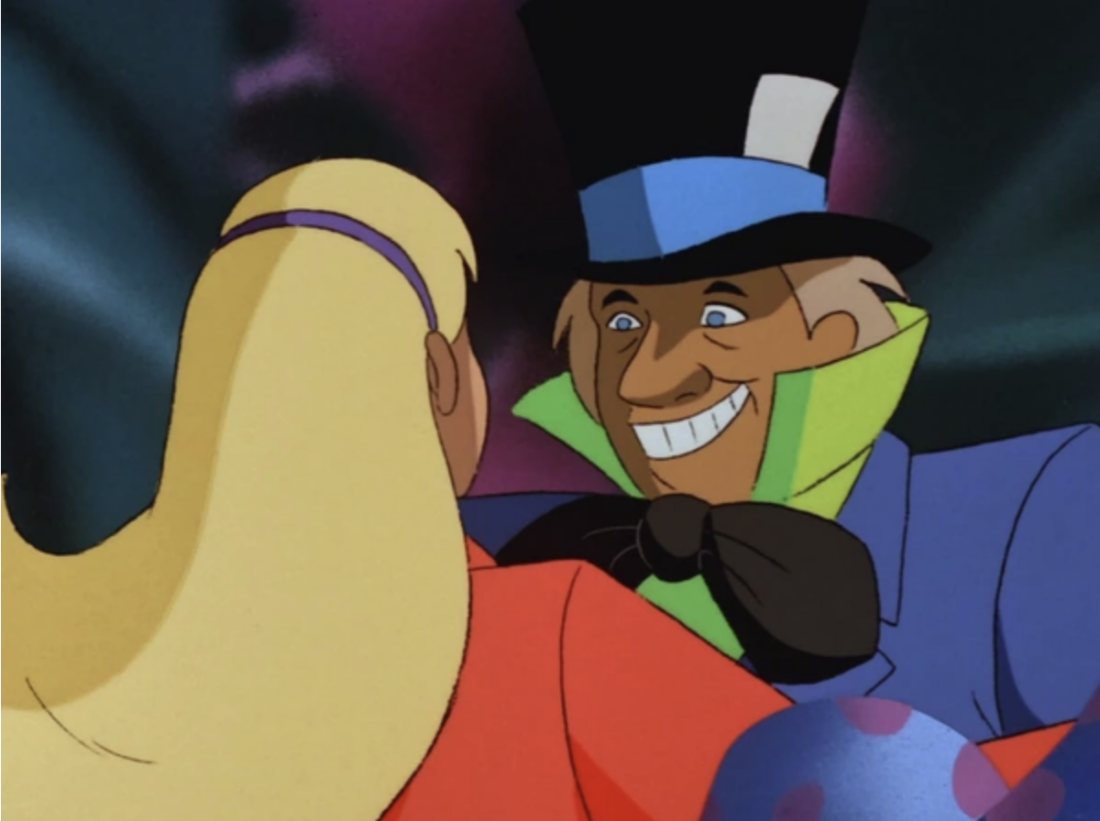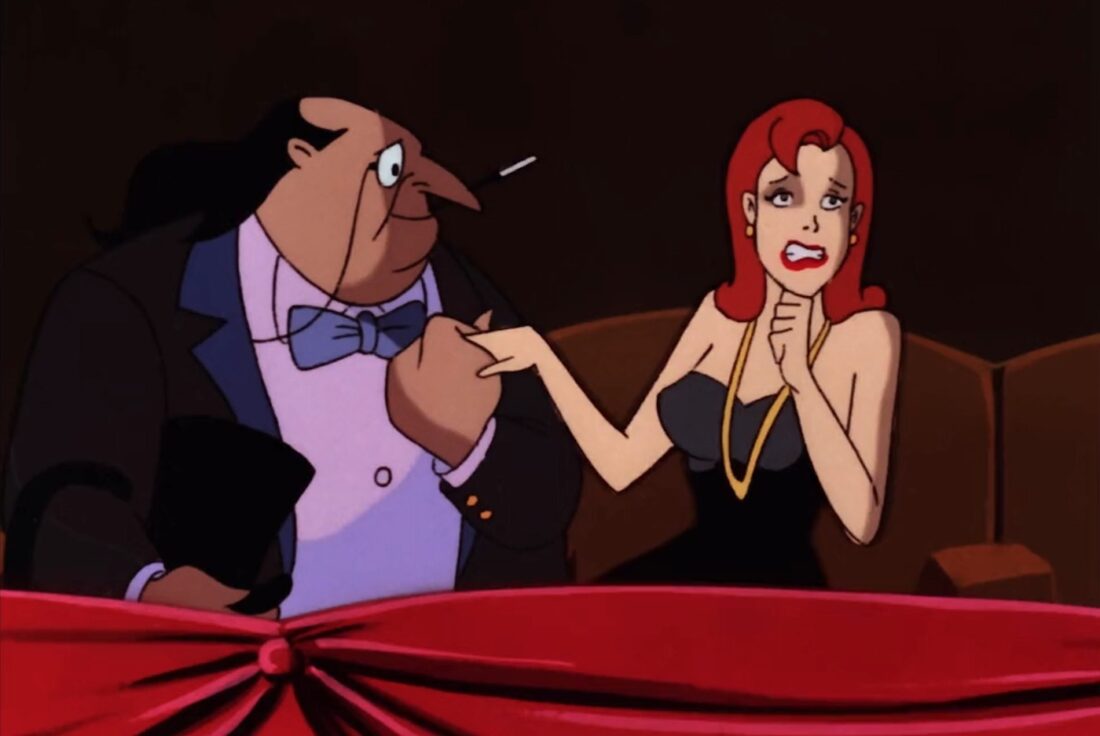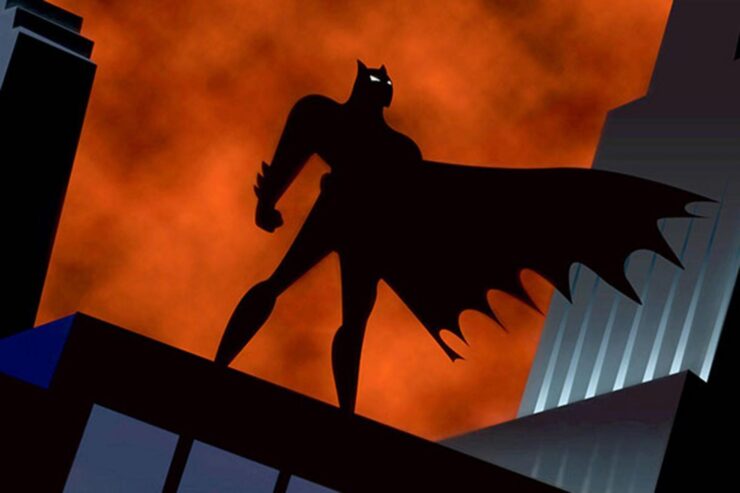Great dramatists are great and versatile lawyers. They make the best case possible for each of their characters. The Batman movies are not good dramas. Tim Burton is not a good lawyer. Christopher Nolan, Todd Phillips, and Matt Reeves should be disbarred.
Burton’s villains are perverse freaks. The wild fetishism of Michelle Pfeiffer’s Catwoman demands admiration, but Jack Nicholson’s Joker and Danny DeVito’s Penguin are cut-out grotesques. The villains in Nolan’s trilogy, produced in the decade following 9/11, are quasi-military terrorists, not one of whom would ever be mistaken for a freedom fighter. The more recent takes on the Rogues Gallery—Joaquin Phoenix’s Joker and Paul Dano’s Riddler—suggest a different set of real-world evils, both of them banal: the incel and the mass shooter.
Can the superhero genre—a genre predicated on the good vs. evil binary—do the work of great drama? Yes, and it has, several times in the comics, and at least once on television, in Batman: The Animated Series, which premiered on Fox in 1992. The show, which borrows freely from Citizen Kane and film noir, is remarkable for its aesthetics. Like Sam Spade, its Batman is only a degree less troubled than his villains.
And those villains are extraordinary tragicomedians. The show’s version of the Joker, unlike Heath Ledger’s, is a man, not a symbol. Mark Hamill’s raspy huff rises to a whiny falsetto within a single line; he is enjoying his perversions, and his disappointments register on his elongated face. He conjures the same sympathy one would grant any unhappy child. Baby Doll, a retired child actress debilitated by a physical condition, retreats into a demented version of the character that made her famous. Mr. Freeze, entrapped in a sub-zero suit, robbed of his beloved wife, has accepted a fate which denies him physical touch. He responds in turn by actively denying his obvious humane instincts.
It requires a particular magic to capture abject loneliness in a genre defined by silly costumes and power fantasies, to make loneliness something both human and superhuman. Baby Doll stares straight into a funhouse mirror where she sees the sophisticated adult woman she can never become. Mr. Freeze sits alone in his frozen cell, contemplating a woman twirling in a snow globe, the image of the wife he cannot save. With only a few notable exceptions—among them “It’s Never Too Late,” an episode in which Batman successfully works on the conscience of an aging drug kingpin— the show acknowledges the fear that we will never be any better than what we are now, that in the end, we are all alone with ourselves.
“Mad as a Hatter” tells the story of Jervis Tetch—here voiced by Roddy McDowall—a hideous man. He falls in love with his assistant Alice, who is herself in love with what we would now call a Chad figure. Tetch becomes the Mad Hatter, and his plot involves mind control, both of random citizens of Gotham, whom he dresses up as foot soldiers borrowed directly from Lewis Carroll, and of Alice herself, whom he transforms from a sweet young woman into an automaton. Batman, as always, wins the battle. In the episode’s final moments, the Mad Hatter lies defeated, trapped under rubble, left to look on as Alice falls into the arms of her lover. McDowall recites the doggerel of the “Lobster Quadrille” with quiet resignation born of frustrated sexuality: “Would not, could not, would not, could not, would not join the dance.”

This is more than a proto-incel fantasy. The Mad Hatter is doomed; as Batman says, even if he had won the battle on his own terms, he would not have joined the dance. And he is of a piece with the show’s other villains, victims either of capitalist overlords, psychosis, self-loathing, bullying, or simply the cruel laws of human existence.
In “Birds of a Feather,” the Penguin attempts to reinvent himself, not as a crime boss, but as the sophisticated fellow he believes himself to be. After his release from prison, he returns to a now empty criminal hideout, where he is greeted by Batman who informs him he is under the detective’s surveillance. “Just what I need,” the Penguin says, “a bat in my belfry.” Meanwhile, Veronica Vreeland and Pierce Chapman, a high-society couple, plot to convince the Penguin to attend one of their soirees. It’s Gotham City’s version of radical chic.
The show’s creators wanted to model the Penguin on the version played by Burgess Meredith in the 1960s television show, a dandy with a monocle, top hat, and long coattails. But Warner Bros. had toys to sell, and they ended up designing a version based on what was then the most recent live-action iteration of the character, the mutant version played by DeVito. This Penguin is short, enormously rotund, with flippers and a long-beaked nose. The creators found a way around the problem by casting Paul Williams, who endowed the character with a posh manner and precise diction, at odds with his physical appearance, thus marking him as a permanent aspirant.
“Penguin was actually trying to go straight and I took the view that Batman was the villain in that show,” the episode’s director Frank Paur told me. “He couldn’t see the change in him. He would just show up and tell him, ‘I’m going to wait for you to fuck up and then I’m going to beat the shit out of you.’” The show’s version of Batman has several motivations—a devotion to justice, comfort with a life of violence, a belief in civic duty, a commitment to noblesse oblige, a horror of death, a need for solitude, a fear of loneliness, and an insatiable intellectual curiosity. He spends most of the episode at a watchful remove. He is fatalistic, and knows this story won’t end well, but he wants to see how it will all play out.
The Penguin is only half-delusional. He plays the role of a proper gentleman, forcing his portly body to stand as straight as possible. Vreeland takes him to a fine restaurant where he horrifies fellow diners by swallowing raw fish whole, and to the opera where he stands in the balcony and howls along with Pagliacci. She compliments his “rapacious wit” and calls his long beak a “fine Roman nose,” eliciting from him a sweet boyish smile. She grows to like him, particularly after he saves her from ruffians in an alleyway; he notes that he associated with a “much higher class of riff-raff” in his criminal career. He has a genuine flair for old-fashioned chivalry, a quality lacking in her world.
At the actual party, the Penguin shows up with a necklace which he hopes to gift to Vreeland. Batman appears just one more time. Love has changed him, the Penguin declares. But of course, it has not. When he overhears Vreeland and Pierce talk about their actual plans for the Penguin, he grows enraged, falls back on his true nature, and seeks revenge. The denouement, and the Penguin’s humiliating defeat, occurs at the opera house. As he is taken away, Vreeland tells him that in truth, she really had grown fond of him. “I suppose it’s true what they say,” he tells her, in an attempt to regain a semblance of dignity. “‘Society is to blame.’ High society that is.”

Batman himself has contempt for the class into which he is born—as well as a willingness to take advantage of his privilege. Unlike his enemies, he can pass. It’s not that hard for him to maintain a secret identity. According to Brynne Chandler, who collaborated on the script, the original dialogue was different. It was Batman who enjoys the final word, and who offers the Penguin comfort, and, with his trademark irony, a sense of solidarity. “It’s for the best,” he says. “She’s not our kind, dear.”
The actor who would have spoken these words was Kevin Conroy, who found inspiration for his performance in a past as traumatic as Bruce Wayne’s. A gay man, born in 1955, he had grown up in a stern, Irish Catholic household, the son of an abusive, alcoholic father who committed suicide, and the brother of a mentally ill sibling. He trained at Julliard, but despite his great talent, his sexuality cost him major roles.
He had bigger problems. The early part of his career coincided with the first decade of the AIDS crisis, and he spent many hours by his friends’ deathbeds, all while remaining the primary caregiver of his mentally ill brother. When he discovered the firm, raspy voice that became his trademark, he was hit by a sensation. “It seemed to come from thirty years of frustration, confusion, denial, love, yearning,” he wrote in an autobiographical comic published shortly before his death in 2022. His Batman, accordingly, is no slummer and he has empathy for all his foes.
Batman: The Animated Series was meant to appeal to a wide audience. Action narratives for the kids. Innuendo and satire for the adults. But none of the above eludes the former’s intelligence. Children have a more sophisticated sense of humor than they are often credited with, and they have an acute knowledge of pain.
The simple, terrible question in Batman: The Animated Series is pre-political. Will you be all that different at 50 from what you were at five? The child fears that nothing will get better, and the adult recognizes that their eccentricities can at best be tempered and their failings managed. Superhero stories have a habit of mistaking a certain concept of “dark”—ultra-violence, graphic sexual assault, dorm-room philosophy, Holocaust references—for “serious.” Batman: The Animated Series is quite serious, and it swallows whole the implications of the saddest convention of the superhero genre: most heroes remain heroes, and villains, villains. “Thou, nature, art my goddess; to thy law / My services are bound.” In the early 1990s, it was the rare show that stood up for its audience of bastards.










